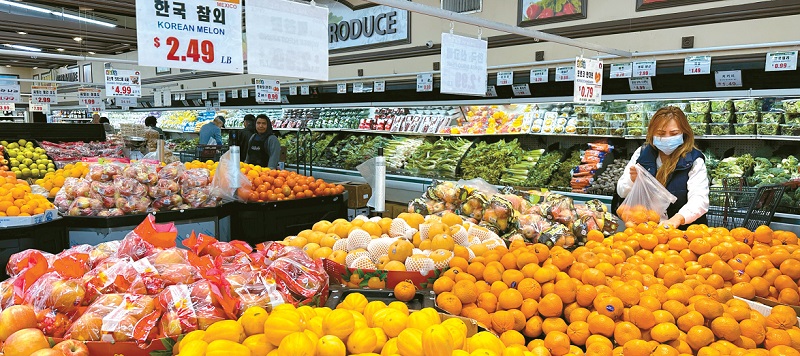
By Dongpil Kim
The author is chief editorial writer of The Korea Daily.
“Everything’s up.” This was the reaction of one of my friends when he told me about spending $50 on two bowls of seollongtang at a restaurant in LA’s Koreatown. When I inquired further, he mentioned that a single bowl cost $20 with tax, plus a $4 tip and $6 for parking for two cars. The days of a “$10 lunch” seem like a distant memory. Despite the upcoming increase in the hourly minimum wage in Los Angeles to $16.78 from July 1, it still won’t be enough to cover a lunch meal.
There’s hardly anything that hasn’t gone up in price. Groceries, consumer goods, services, and even golf course green fees and parking have all seen price hikes. Inflation is the main culprit behind these rising costs, and many housewives express fear when going to the market.
Last year, the monthly consumer price index (CPI) experienced a year-over-year increase of 8-9%, marking the highest inflation rate in 40 years. Although the rate of increase has recently slowed down somewhat, it remains high. As a result of high inflation, ordinary people are witnessing a decline in the value of their assets and income.
Inflation has various causes, including supply chain disruptions during the COVID-19 pandemic, rising energy prices due to the conflict in Ukraine, government pandemic aid, and increasing wages.
The Federal Reserve Board has been battling inflation for the past two years. Within a year, it raised interest rates from 0-0.25% to 5-5.25% to combat inflation. Despite concerns that rapid rate hikes could trigger a recession, the Fed remains resolute. During his recent appearance before Congress, Fed Chair Jerome Powell emphasized the necessity to “fight inflation” and even mentioned the possibility of another rate hike in the second half of the year to maintain inflation at 2%. Powell’s determination has led experts to believe that the key interest rate will rise to 5.5-5.75% later this year.

This is why the debate on “Greedflation” is gaining traction. The term “Greedflation” combines “greed” and “inflation,” suggesting that corporate greed to maximize profits is driving price hikes. In other words, companies are using the shield of “inflation” to increase prices at will, thus perpetuating inflation. In this situation, the Fed’s ability to control inflation, regardless of how much it raises interest rates, is limited.
Supporting this argument is the fact that the 500 largest U.S. companies in the Fortune 500 reported record profits last year, during the peak of inflation. These companies accumulated $16.1 trillion in sales and $1.8 trillion in profits. Moreover, many CEOs view inflationary times as advantageous. They argue that inflation facilitates price increases, enabling companies to boost their bottom line.
Of course, there is a counter-argument. Some believe that the current inflation is not solely driven by “Greedflation” but rather by rising commodity prices and wages. According to this perspective, now that commodity prices have stabilized due to the recovery of the supply chain, inflation will subside once the uncertain job market normalizes.
Regardless of whether inflation is attributed to “Greedflation” or not, one way to exercise consumer rights is to avoid establishments with excessive price increases.

![North Korean leader’s sister calls South, U.S., Japan denuclearization efforts ‘hostile act’ Kim Yo-jong, sister of North Korean leader Kim Jong-un [YONHAP]](https://www.koreadailyus.com/wp-content/uploads/2025/04/0408-Yojong-100x70.jpg)
![Korean Air fires two pilots after debate turns into brawl over Yoon impeachment A Korean Air flight takes off at Incheon International Airport in Incheon on July 4, 2022. [YONHAP]](https://www.koreadailyus.com/wp-content/uploads/2025/04/0408-pilot-100x70.jpg)
![Acting president Han, Trump hold half-hour phone call Acting President of Korea Han Duck-soo, left, and U.S. President Donald Trump [YONHAP]](https://www.koreadailyus.com/wp-content/uploads/2025/04/0408-call-100x70.jpg)
![North Korean troops cross Military Demarcation Line, retreat after South’s warning shots A picture of North Korean soldiers disclosed by the Joint Chiefs of Staff on Dec. 23, 2024 [JOINT CHIEFS OF STAFF]](https://www.koreadailyus.com/wp-content/uploads/2025/04/0408-incursion-100x70.jpg)